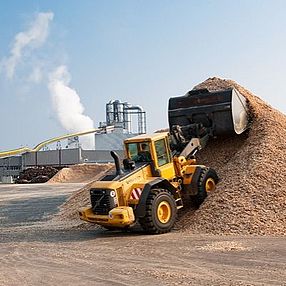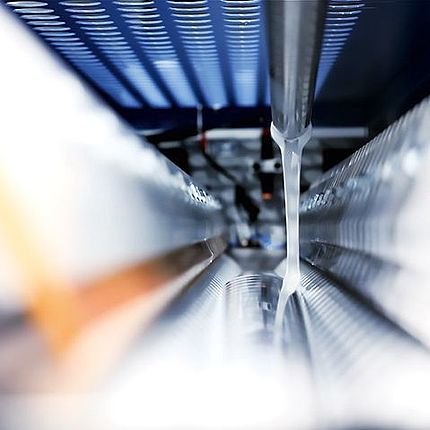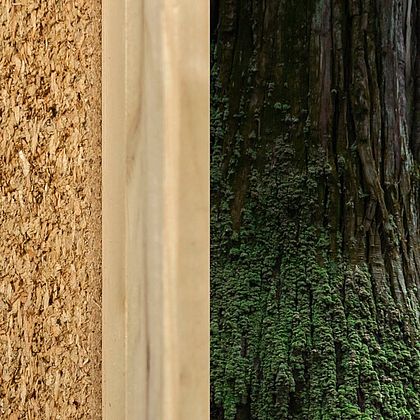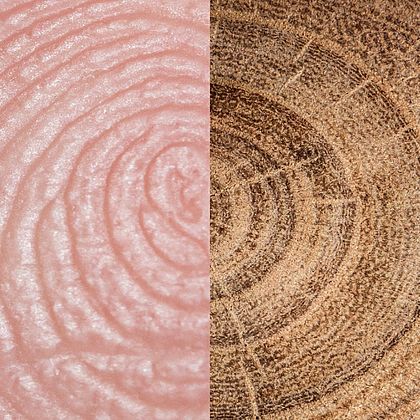Target 1
Reducing Scope 1 and Scope 2 greenhouse gas emissions by 21% by 2025

Pfleiderer is committed to the Paris Climate Agreement’s goal of limiting global warming to 1.5 °C. This goal guides our measures to reduce climate-relevant emissions in all three scopes. By 2050, we want to reduce gradually our net carbon footprint to zero.
Through investments and further measures at our locations between 2020 and 2023, we have already been able to shrink emissions in Scope 1 and especially Scope 2 significantly and achieve values at the 2025 target level. For example, we caused 129,914 tonnes of greenhouse gas emissions in Scopes 1 and 2 in 2024, compared to 150,846 tonnes in 2022 and 220,164 tonnes in 2020.
We have thus reduced greenhouse gas emissions in Scope 1 and 2 by 41% from 2020 to 2024.
In 2023, we transitioned to self-supply; the three CHP plants feed the electricity into a virtual power plant from which five locations draw their electricity simultaneously. In 2024 we thus covered 97% of our energy consumption for heat and electricity from own combined heat and power generation.
Company carbon footprint: our performance and target
| 2020 | 2021 | 2022 | 2023 | 2024 | Target 2025 | |
| Company carbon footprint (tCO2) | 220,164 | 171,134 | 150,846 | 134,894 | 129,914 | 173,929 |
| % decrease (on 2020 baseline) | Baseline | 21.9 | 31.4 | 38.7 | 41.0 | 21.0 |
“We have a strong track record in reducing CO2 emissions, are setting targets that align with SBTI, AND WE ARE EXPANDING HOW WE ACCOUNT FOR AND REDUCE OUR SCOPE 3 EMISSIONS1.”2
Dr. Axel Knörr
Head of Environment
1 For definitions on the Scopes, please refer to https://ghgprotocol.org/calculationg-tools-faq
2 The target was set following engagement with the SBTi and is informed by decarbonisation pathways applicable to the furniture and fittings sector, as well as the SBTi Absolute Contraction approach pathway. See sciencebasedtargets.org
Case Study 1

Three sites, three high-efficiency CHP plants
100% of the energy produced at our CHP plants comes from biomass. On three of our key sites, we use an integrated combined heat and power (CHP) plant that provides simultaneous generation of mechanical energy for electricity and usable heat for production processes. Combined heat and power generation allows fuel savings of up to one third of the primary energy, compared to the separate generation of electricity and heat. The advantage of cogeneration is reduced fuel requirement and lower emissions.
100%
Biomass fuels 100% of energy produced at our CHP plants
Case Study 2

Planning for success
All Pfleiderer sites are certified to the ISO 50001 Energy Management Standard. Energy planning is carried out in coordination with the distribution, production and purchasing teams and is updated frequently.
Our planning accounts for forwardlooking business assessments and actual consumption. Based on energy data collected at all our sites, we regularly assess and analyse the usage and consumption of energy, creating energy registers to identify improvements.
Case Study 3
Efficient use of energy
The efficient use of energy becomes even more important in times of supply shortages. Accordingly, the feeding of waste heat from industrial production into the supply networks will become more important to enable climate-friendly and more cost-effective heating of connected households.
In the first phase, which began in 2022, waste heat from a natural gas-fired boiler will be used and the hot exhaust gases from the natural gas will be transferred via a heat exchanger. In a second step, additional larger sources of waste heat from the biomass boiler can be integrated to feed into the municipal network. This became reality in 2024, when the Leutkirch site began feeding waste heat into the municipal network, reducing energy costs for residents.
Target 2
Reduce fossil fuel consumption of our own fleet by 5% by 2030

To achieve our target, we first implement measures to reduce our energy consumption and thus our use of fossil fuels. To reduce our energy consumption, empty runs are kept to a minimum through a well thought out route planning.
To further decrease the carbon emissions associated with our own fleet, we have set the goal of lowering fuel consumption by an additional 5% by 2030 by leveraging new technologies, optimising tyres and implementing continuous training of the drivers.
Target 3
Reducing indirect greenhouse gas emissions associated with purchased chemical products used in our wood-based panels by 21% by 2025 (baseline 2020)

The chemical products we buy for our wood-based material production include adhesives, titanium dioxide, urea, paraffin, flame retardants, resins, paints and other melting products. Their production is energy- intensive. That is why we work with our chemical suppliers to reduce emissions from chemical production, especially through the use of renewable energy sources.
In addition, we are looking for alternatives to fossil-based chemicals. For example, we are increasingly replacing urea-formaldehyde resin glues (UF glues) – the most widely used binder in the global wood industry – with organic, biogenic glue in our particleboards. This allows us to improve the products' carbon footprint while maintaining quality and meeting all applicable quality and safety standards.

Case Study 4
OrganicBoard Pure
OrganicBoard Pure is manufactured with 100% recycled wood and 100% OrganicGlue - a biogenic glue. This means that the use of internationally procured fossil gas in production can be reduced by over 30% without compromising on product quality. OrganicBoard Pure sets new standards in regional and renewable resources use. About the product.
Target 4
Switching the whole fleet to comply with the EU emission standard 6e by 2025

In logistics, we use our own trucks from our company JURA-Spedition; we finalized to switch the full fleet the Euro emissions standard 6d in 2023 due to regular replacements. We have now set the target to fully comply with the EU emissions standard 6e by 2025, and we are already preparing for higher standards such as Euro 7 as well as alternative drive types. E-mobility plays a decisive role for our employees; we therefore have introduced offering electric fleet cars and job bikes in 2023.
Read more about sustainability at Pfleiderer
These topics may also be of interest to you:


